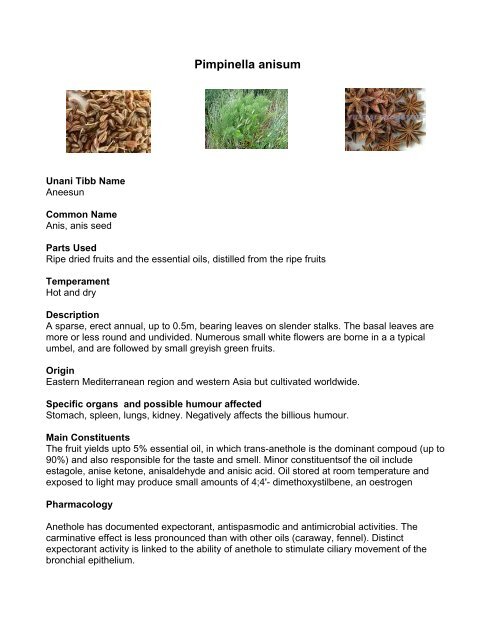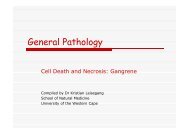Pimpinella anisum - Free Courseware at UWC
Pimpinella anisum - Free Courseware at UWC
Pimpinella anisum - Free Courseware at UWC
Create successful ePaper yourself
Turn your PDF publications into a flip-book with our unique Google optimized e-Paper software.
Unani Tibb Name<br />
Aneesun<br />
Common Name<br />
Anis, anis seed<br />
<strong>Pimpinella</strong> <strong>anisum</strong><br />
Parts Used<br />
Ripe dried fruits and the essential oils, distilled from the ripe fruits<br />
Temperament<br />
Hot and dry<br />
Description<br />
A sparse, erect annual, up to 0.5m, bearing leaves on slender stalks. The basal leaves are<br />
more or less round and undivided. Numerous small white flowers are borne in a a typical<br />
umbel, and are followed by small greyish green fruits.<br />
Origin<br />
Eastern Mediterranean region and western Asia but cultiv<strong>at</strong>ed worldwide.<br />
Specific organs and possible humour affected<br />
Stomach, spleen, lungs, kidney. Neg<strong>at</strong>ively affects the billious humour.<br />
Main Constituents<br />
The fruit yields upto 5% essential oil, in which trans-anethole is the dominant compoud (up to<br />
90%) and also responsible for the taste and smell. Minor constituentsof the oil include<br />
estagole, anise ketone, anisaldehyde and anisic acid. Oil stored <strong>at</strong> room temper<strong>at</strong>ure and<br />
exposed to light may produce small amounts of 4;4'- dimethoxystilbene, an oestrogen<br />
Pharmacology<br />
Anethole has documented expectorant, antispasmodic and antimicrobial activities. The<br />
carmin<strong>at</strong>ive effect is less pronounced than with other oils (caraway, fennel). Distinct<br />
expectorant activity is linked to the ability of anethole to stimul<strong>at</strong>e ciliary movement of the<br />
bronchial epithelium.
Uses & Indic<strong>at</strong>ion<br />
The fruit and the oil are the traditional remedy for c<strong>at</strong>arrh of the respir<strong>at</strong>ory tract (colds and flu,<br />
cough, bronchitis) and also for dyspeptic complaints (indigestion, fl<strong>at</strong>ulence, colic). At high<br />
doses, the oil is antiseptic and antispasmodic, and has been used as a stimul<strong>at</strong>ing liniment<br />
and against ectoparasites. Many cough remedied and other medicinal products contain<br />
aniseed extract or aniseed oil, not only for its medicinal properties (antitussive, expectorant)<br />
but also to improve the flavour and taste.<br />
Dosage and mode of administr<strong>at</strong>ion<br />
A tea is prepared from 3g of ripe fruits, crushed immedi<strong>at</strong>ely before use. The daily dose<br />
should not exceed 5g of the fruit or 0.3g of oil.<br />
Infusions and galenical prepar<strong>at</strong>ions for internal use or inhal<strong>at</strong>ion.<br />
Precaution<br />
Occasional allergic reactions of the skin, respir<strong>at</strong>ory tract and gastrointestinal tract.<br />
REFERENCE<br />
1.Medicinal Plants of the World - Ben-Erik Van Wyk / Micheal Wink<br />
2.books.google.co.za/books?isbn=0941524272... -



